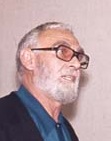Jorge Oteiza: Difference between revisions
Adjusted nationality as per Wikipedia:Manual of Style/Biographies#Context. |
Undid revision 842926502 by BallenaBlanca (talk) Rv contentious, one-purpose editing |
||
| Line 2: | Line 2: | ||
[[File:Jorge Oteiza.jpg|thumb|Jorge Oteiza]] |
[[File:Jorge Oteiza.jpg|thumb|Jorge Oteiza]] |
||
[[File:Oteiza Apostoluak Arantzazu.jpg|thumb|250px|Oteiza ''Apostoluak (The [[twelve apostles|apostles]])'', [[sculptures]] on the [[Monastery]] of [[Arantzazu]], hollowed out stone, 1950]] |
[[File:Oteiza Apostoluak Arantzazu.jpg|thumb|250px|Oteiza ''Apostoluak (The [[twelve apostles|apostles]])'', [[sculptures]] on the [[Monastery]] of [[Arantzazu]], hollowed out stone, 1950]] |
||
'''Jorge Oteiza Enbil''' (October 21, 1908 – April 9, 2003), was a [[ |
'''Jorge Oteiza Enbil''' (October 21, 1908 – April 9, 2003), was a [[Basque people|Basque]] [[Spanish people|Spanish]] [[sculpture|sculptor]], [[painting|painter]], [[design]]er and [[writing|writer]], renowned for being one of the main theorists on Basque [[modern art]].<ref>{{Cite news|url=https://www.nytimes.com/2005/07/08/arts/design/08glue.html|title='Emptying' Sculpture to Make Room for Spiritual Energy|author=Grace Glueck|date=2005-07-08|accessdate=2010-03-02|work=The New York Times}}</ref><ref name=basque>{{Cite book|title=Basques, today |first=Ramón |last=Zallo |publisher=Alberdania |year=2007 |page=144 |isbn=978-84-96643-59-8}}</ref> |
||
Oteiza was born in [[Orio]] ([[Gipuzkoa |
Oteiza was born in [[Orio]] ([[Gipuzkoa]]).<ref name=basque/> He moved to South America in 1935, just before the [[Spanish Civil War]], and stayed there for 14 years.<ref>{{Cite book|title=Oteiza's selected writings |first1=Jorge |last1=de Oteiza |first2=Joseba |last2=Zulaika |publisher=University of Nevada Press |year=2003 |page=12 |isbn=978-1-877802-43-0}}</ref> In 1963 he published ''Quosque tandem!'', an [[essay]] about the aesthetics inherent to Basque soul, based on Basque [[pre-historic art|prehistoric art]] and Basque people's [[anthropological]] roots.<ref>Oteiza; Zulaika (2003), p. 286</ref> Three years on, he contributed to found the [[Gaur (artistic group)|artistic group Gaur]]. |
||
He died in [[San Sebastián]], [[Gipuzkoa]], in 2003.<ref name=basque/> Following his will, a month after his death a [[museum]] dedicated to his career was opened in Alzuza, [[Navarre]], in the place where he had lived since 1975. The [[Oteiza Museum]] is a monographic exhibition space housing the personal collection of Jorge Oteiza, which includes 1,690 sculptures, 2,000 experimental pieces from the artist’s Chalk Laboratory, and an extensive collection of drawings and collages.<ref>[http://www.museooteiza.org/?page_id=27 "Oteiza Museum: General Information,"] from the Oteiza Museum's website. Retrieved 2010-11-08.</ref> |
He died in [[San Sebastián]], [[Gipuzkoa]], in 2003.<ref name=basque/> Following his will, a month after his death a [[museum]] dedicated to his career was opened in Alzuza, [[Navarre]], in the place where he had lived since 1975. The [[Oteiza Museum]] is a monographic exhibition space housing the personal collection of Jorge Oteiza, which includes 1,690 sculptures, 2,000 experimental pieces from the artist’s Chalk Laboratory, and an extensive collection of drawings and collages.<ref>[http://www.museooteiza.org/?page_id=27 "Oteiza Museum: General Information,"] from the Oteiza Museum's website. Retrieved 2010-11-08.</ref> |
||
Revision as of 21:40, 27 May 2018


Jorge Oteiza Enbil (October 21, 1908 – April 9, 2003), was a Basque Spanish sculptor, painter, designer and writer, renowned for being one of the main theorists on Basque modern art.[1][2] Oteiza was born in Orio (Gipuzkoa).[2] He moved to South America in 1935, just before the Spanish Civil War, and stayed there for 14 years.[3] In 1963 he published Quosque tandem!, an essay about the aesthetics inherent to Basque soul, based on Basque prehistoric art and Basque people's anthropological roots.[4] Three years on, he contributed to found the artistic group Gaur.
He died in San Sebastián, Gipuzkoa, in 2003.[2] Following his will, a month after his death a museum dedicated to his career was opened in Alzuza, Navarre, in the place where he had lived since 1975. The Oteiza Museum is a monographic exhibition space housing the personal collection of Jorge Oteiza, which includes 1,690 sculptures, 2,000 experimental pieces from the artist’s Chalk Laboratory, and an extensive collection of drawings and collages.[5]
Main prizes and awards
Jorge Oteiza was granted several prizes and awards throughout his life:[6]

- 1953 — Only Spanish sculptor selected for the international competition for the Monument to the Unknown Political Prisoner. The project is exhibited in the Tate Gallery (London).
- 1954 — Spanish National Award of Architecture, for a project to do a chapel on the Road to Santiago. It was a joint project, together with architects F. J. Sáenz de Oiza and Luis Romaní, and it was not carried out.
- 1957 — Grand Prix for his sculpture at the IV São Paulo Art Biennial (Brazil).
- 1970 — First Prize in the competition for the urban planning of the Plaza de Colón in Madrid. It was a joint project, together with Angel Orbe, Mario Gaviria and Luis Arana, and it was not carried out.
- 1985 — Gold Medal for Fine Arts, awarded by the Spanish Ministry of Culture.
- 1986 — Selected for the exhibition Qu’est-ce que la sculpture moderne? 1900-1970, held in the Museum of Modern Art at the Georges Pompidou Center in Paris.
- 1988 — Prince of Asturias Prize for the Arts.
- 1991 — Gold Medal of Navarre, awarded by the Government of Navarre.
- 1995 — Manuel Lekuona prize by Eusko Ikaskuntza (Society of Basque Studies).
- 1996 — Pevsner Prize (Paris), in recognition of his life’s work.
- 1996 — Honorary member of the Vascon-Navarrese Architect’s Association.
- 1998 — Doctor honoris causa by the University of the Basque Country.
- 1998 — Madrid Fine Arts Circle Medal.
- 1998 — Gipuzkoa Gold medal.
References
- ^ Grace Glueck (2005-07-08). "'Emptying' Sculpture to Make Room for Spiritual Energy". The New York Times. Retrieved 2010-03-02.
- ^ a b c Zallo, Ramón (2007). Basques, today. Alberdania. p. 144. ISBN 978-84-96643-59-8.
- ^ de Oteiza, Jorge; Zulaika, Joseba (2003). Oteiza's selected writings. University of Nevada Press. p. 12. ISBN 978-1-877802-43-0.
- ^ Oteiza; Zulaika (2003), p. 286
- ^ "Oteiza Museum: General Information," from the Oteiza Museum's website. Retrieved 2010-11-08.
- ^ "Biography," from the Oteiza Museum's website. Retrieved 2010-11-08.
External links
- Oteiza Museum in Alzuza, Navarre
- Biography
- Oteiza's Selected Writings at the Basque Database
- Two Basque Sculptors. Peter Selz on Oteiza and Chillida[permanent dead link]
- Arana Cobos, Juan (2008). Jorge Oteiza: Art as Sacrament, Avant-Garde and Magic. PhD dissertation, Center for Basque Studies. University of Nevada, Reno.
